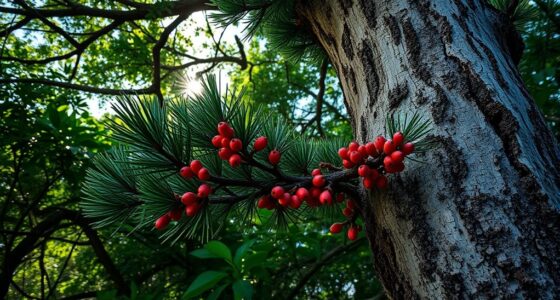Propagating endangered plants at home helps conserve species and supports biodiversity. To succeed, you need to understand their specific needs, such as soil, light, and moisture conditions. Using seed germination techniques or cuttings, you can grow these plants responsibly without harming wild populations. Proper care, monitoring, and patience are key. Continuing with this guide will give you all the tips and techniques needed to successfully grow and contribute to conservation efforts.
Key Takeaways
- Research species-specific needs to replicate natural conditions for successful propagation.
- Utilize appropriate methods like seed germination, cuttings, or layering based on the plant type.
- Maintain optimal soil, light, moisture, and temperature conditions tailored to each endangered species.
- Monitor and manage pests and diseases to ensure healthy plant growth.
- Contribute to conservation efforts by growing plants at home to support biodiversity and habitat restoration.

Have you ever wondered how we can help save endangered plants from extinction? One of the most effective ways is through propagation, which allows you to grow at-risk species at home and contribute to their survival. To do this successfully, understanding and implementing proper conservation strategies is essential. These strategies often include habitat restoration, which aims to recreate or improve the natural environments that endangered plants need to thrive. Restoring habitats can help increase the plants’ chances of survival in the wild, but propagating them at home provides an immediate, hands-on approach to conservation.
Propagating endangered plants at home supports conservation and habitat restoration efforts.
When starting out, it’s crucial to research the specific needs of the endangered plant species you want to grow. Each species has unique requirements for soil, light, moisture, and temperature. By replicating these conditions as closely as possible, you create a supportive environment that encourages healthy growth. This process aligns with broader conservation strategies, which emphasize maintaining genetic diversity and avoiding invasive practices. Propagation at home should be done responsibly, guaranteeing that you’re not unintentionally harming wild populations or introducing diseases. Additionally, utilizing proper propagation techniques ensures the health and sustainability of your efforts.
To propagate endangered plants effectively, consider starting with seeds or cuttings, depending on the species. Seeds often require specific germination conditions, such as stratification or scarification, which mimic natural processes that break seed dormancy. Cuttings, on the other hand, can be rooted in a suitable growing medium, such as moist soil or water, with careful attention to maintaining high humidity and proper lighting. Whichever method you choose, patience and consistency are key. Regular monitoring for pests and diseases is also important to prevent setbacks that could jeopardize your efforts.
Involving yourself in propagation projects can also support habitat restoration efforts, which are essential for the long-term survival of these plants. By growing endangered species at home, you create a backup population and reduce pressure on wild populations. Additionally, your efforts can contribute data to conservation programs and help raise awareness about endangered plants. Many organizations welcome volunteers and enthusiasts who are passionate about plant preservation, and they often provide guidance or resources to guarantee your propagation techniques are effective and sustainable.
Ultimately, propagating endangered plants at home isn’t just a rewarding hobby—it’s a meaningful way to participate in conservation strategies. By restoring habitats and growing these plants with care, you help safeguard biodiversity for future generations. Your small, dedicated efforts can make a significant difference, turning your home into a mini refuge for species teetering on the brink of extinction.
Frequently Asked Questions
Can Endangered Plants Be Grown Indoors Successfully?
Yes, you can successfully grow endangered plants indoors. To do so, guarantee they get adequate indoor lighting, mimicking their natural sunlight needs. You’ll also want to use the right soil requirements—well-draining and nutrient-rich soil is essential. By providing proper light and soil conditions, you create a thriving environment, helping endangered plants survive and even flourish in your home.
What Are the Legal Considerations for Propagating Protected Species?
You should be aware that propagating protected species involves strict regulations compliance and permitting requirements. Before you start, check local, national, and international laws, as unauthorized propagation can lead to fines or legal action. Always obtain necessary permits, and confirm you’re following conservation guidelines. This way, you contribute to protecting endangered plants responsibly while avoiding legal issues, making your efforts both ethical and lawful.
How Do I Identify if a Plant Is Truly Endangered?
To identify if a plant is truly endangered, you need to check its conservation status through reliable sources like the IUCN Red List or local conservation agencies. Use identification techniques such as examining distinctive features and habitat. If the plant appears rare, limited in distribution, or declining, it may be endangered. Always verify with authoritative data before considering propagation, ensuring you respect conservation efforts.
What Common Pests Threaten At-Risk Plant Species?
You want to know about common pests threatening at-risk plant species. First, identify pests like aphids, spider mites, or whiteflies through pest identification techniques. To protect your plants, implement pest prevention strategies such as regular inspections, maintaining proper humidity, and using natural predators or organic treatments. Staying vigilant and acting early helps prevent infestations that could further endanger these delicate plants, ensuring they thrive in your care.
How Can I Create the Ideal Environment for Rare Plant Propagation?
Think of your rare plants as delicate dreams needing precise nurturing. You create the ideal environment through microclimate control, adjusting humidity and temperature to mimic their natural habitat. Focus on soil composition, blending organic matter and proper drainage to support healthy growth. By tending to these details, you foster resilience and survival, ensuring these endangered species thrive in your care, symbolizing hope and renewal for their future.
Conclusion
By growing these endangered plants at home, you’re not just gardening—you’re saving the world’s most precious treasures from extinction! Your tiny pots become battlegrounds for survival, fighting against oblivion. With each seed you nurture, you’re creating a future where these incredible species thrive once more. Imagine the awe and pride you’ll feel knowing you’re a hero in the fight to preserve our planet’s fragile beauty. Your hands hold the power to change history—start propagating today!










